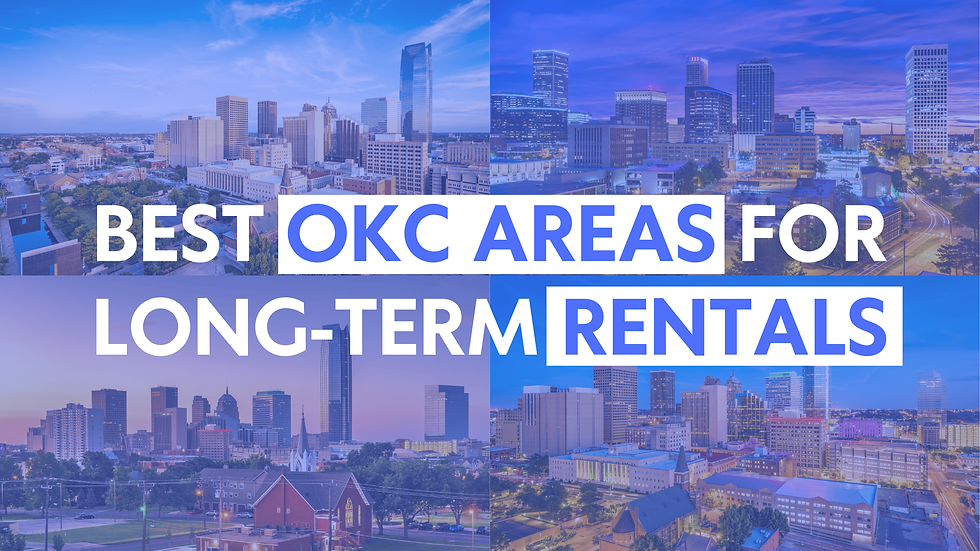Oklahoma City Market Snapshot: Why Investors Keep Coming Back
- norcalpropertiesan
- Sep 4
- 5 min read

When people think of top real estate markets in the U.S., cities like Austin, Nashville, or Phoenix usually come to mind. But savvy investors are increasingly turning their eyes to Oklahoma City (OKC).
As the 20th largest city in America, OKC offers an unbeatable combination of affordability, economic growth, and strong rental demand. Whether you’re a cash-flow investor or long-term wealth builder, the city consistently delivers above-average returns with below-average entry costs.
In this comprehensive market snapshot, we’ll explore:
Why OKC is a magnet for both local and out-of-state investors
The city’s economic drivers, population growth, and job market
Rental performance and demand trends
The most promising neighborhoods for long-term investing
Investor strategies that work best in Oklahoma City
Risks to watch out for and how to mitigate them
By the end, you’ll understand exactly why investors keep coming back to Oklahoma City — and how you can position yourself for long-term success in this market.
1. Oklahoma City by the Numbers: An Overview
Before diving deeper, let’s look at the fundamentals:
Metro Population (2025): ~1.45 million and growing steadily
Median Home Price: ~$210,000 (well below U.S. average of ~$400,000)
Median Rent: ~$1,250 for a 3-bedroom single-family home
Unemployment Rate: Consistently below national average (~3.5–4%)
Top Industries: Energy, aerospace, healthcare, logistics, tech, government
Key takeaway: The combination of affordability and economic stability makes OKC a market where investors can achieve both cash flow and appreciation.
2. Affordability: Low Entry Costs with Strong Returns
How OKC Compares Nationally
While coastal investors face $600k–$1M entry points, OKC’s median home price of around $210k makes it accessible to new investors and allows seasoned investors to scale faster.
Example:
Buying a $200,000 single-family home in OKC with 20% down ($40,000)
Monthly rent: ~$1,500
After mortgage, taxes, insurance, and management, monthly cash flow could be ~$250–$400.
That’s a solid 6–8% cash-on-cash return, much higher than what you’d find in markets like Los Angeles or Seattle where many properties run at negative cash flow.
3. Economic Drivers: Why OKC’s Growth is Sustainable
Energy and Beyond
Traditionally an oil-and-gas hub, OKC has diversified into aerospace, healthcare, and logistics. Tinker Air Force Base, one of the largest employers in the state, anchors the aerospace industry.
Healthcare Growth
OU Health, Integris Health, and other major hospital systems provide thousands of jobs and attract both professionals and patients to the city.
Logistics & Infrastructure
Located at the crossroads of I-35, I-40, and I-44, OKC is a national logistics hub. Amazon and FedEx have both invested in large distribution centers.
Tech & Entrepreneurship
Oklahoma City is home to a growing startup ecosystem, supported by affordable costs of living and business-friendly policies.
Key takeaway: OKC is no longer a one-industry town. Its diversified economy cushions it from volatility and attracts long-term population growth.
4. Population Growth: Steady, Not Speculative
Unlike boom-and-bust cities, OKC’s population growth is steady and sustainable. From 2010 to 2020, the metro added nearly 200,000 residents — and growth has continued at ~1.5% annually since.
This matters for investors because:
More residents = more renters
A growing population puts upward pressure on home prices and rents
Migration is driven by affordability, jobs, and quality of life — not speculation
5. Rental Market Performance
High Occupancy Rates
Vacancy rates in OKC hover around 5–6%, lower than many national averages. Landlords benefit from steady demand across multiple renter demographics.
Who’s Renting in OKC?
Young professionals drawn by jobs and affordability
Families who rent before buying
Students at Oklahoma City University, OU Health Sciences Center, and nearby University of Oklahoma in Norman
Military personnel linked to Tinker Air Force Base
Rent Growth Trends
While OKC rent growth is not as explosive as Austin’s or Miami’s, it has been consistently positive year over year. This provides stable, predictable income for landlords.
6. Landlord-Friendly Environment
For out-of-state investors, landlord laws matter. Oklahoma is one of the more landlord-friendly states in the U.S.:
Evictions: Faster than tenant-heavy states like California or New York.
Taxes: Property tax rates are relatively low (~0.87% average).
No Rent Control: Landlords can adjust rents based on market conditions.
This legal and tax environment makes OKC particularly attractive for long-distance investors.
7. Best Neighborhoods for Investors
Uptown & Midtown
Young professionals and students
Mix of historic homes and modern apartments
Walkable, trendy areas with strong rental demand
Edmond
Suburban feel, great schools, high demand from families
Slightly higher property prices but premium rents
Norman (near OU)
Student housing hub
High rental turnover but steady demand
South OKC
More affordable, blue-collar neighborhoods
Strong cash-flow potential
Downtown/Bricktown
Popular with young renters and professionals
Strong appreciation potential due to redevelopment
8. Investment Strategies That Work in OKC
Buy-and-Hold Rentals → Great for steady cash flow and appreciation.
BRRRR (Buy, Rehab, Rent, Refinance, Repeat) → Plenty of value-add properties available under $150k.
Short-Term Rentals (Airbnb/VRBO) → Popular in Downtown, Bricktown, and near major hospitals, though regulations should be monitored.
House Hacking → Duplexes and triplexes allow investors to live in one unit and rent others.
9. Risks & How to Mitigate Them
Every market has risks. In OKC, consider:
Weather Risks: Tornadoes and hailstorms → Always carry strong insurance.
Older Housing Stock: Many homes need upgrades → Budget for CapEx.
Neighborhood Variability: Not all areas perform equally → Do local research or work with experienced investors/agents.
10. Frequently Asked Questions (FAQs)
Why Investors Keep Coming Back
Oklahoma City combines what every real estate investor wants: affordability, stability, and growth potential. With its diversified economy, strong rental demand, landlord-friendly laws, and affordable entry costs, OKC is a market that delivers consistent results for both local and out-of-state investors.
Whether you’re new to real estate or looking to expand your portfolio, Oklahoma City deserves serious consideration. It may not have the hype of Austin or Miami, but it has something better: long-term reliability.


Comments